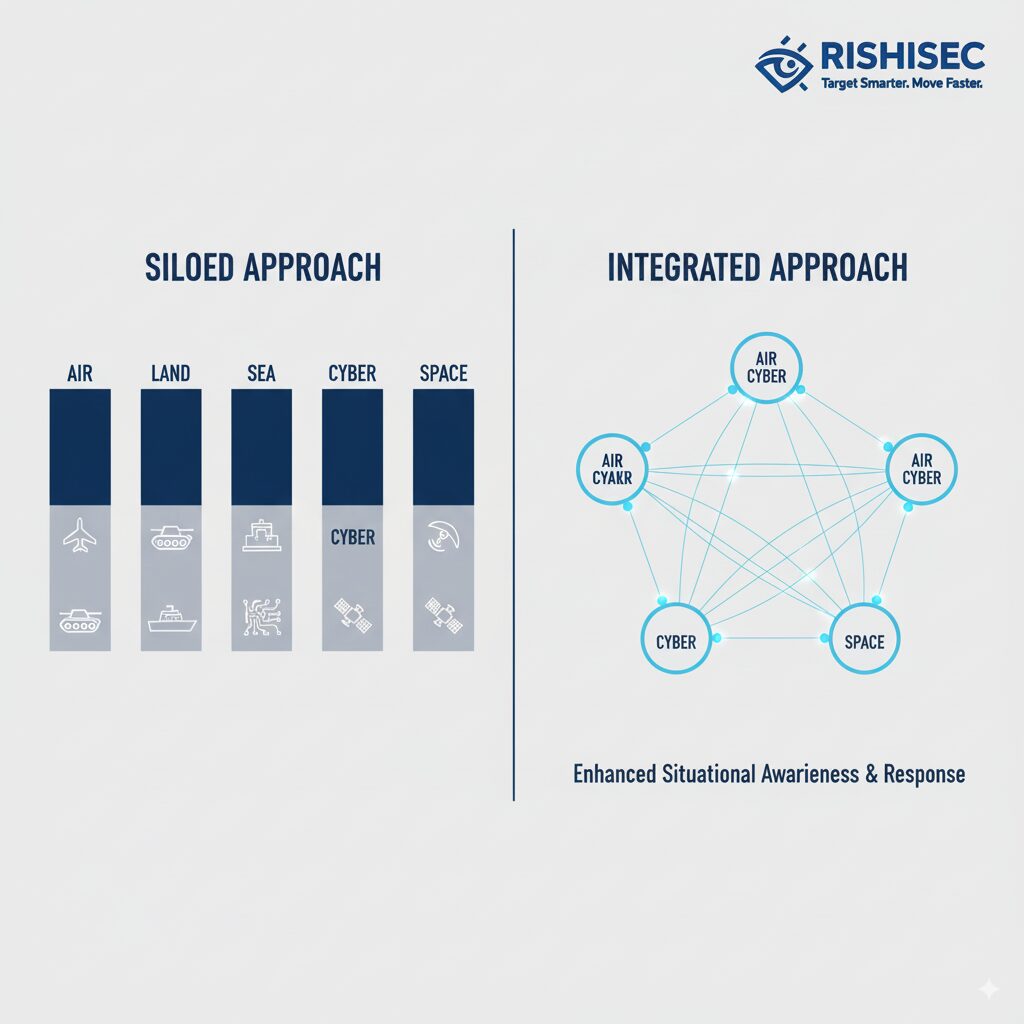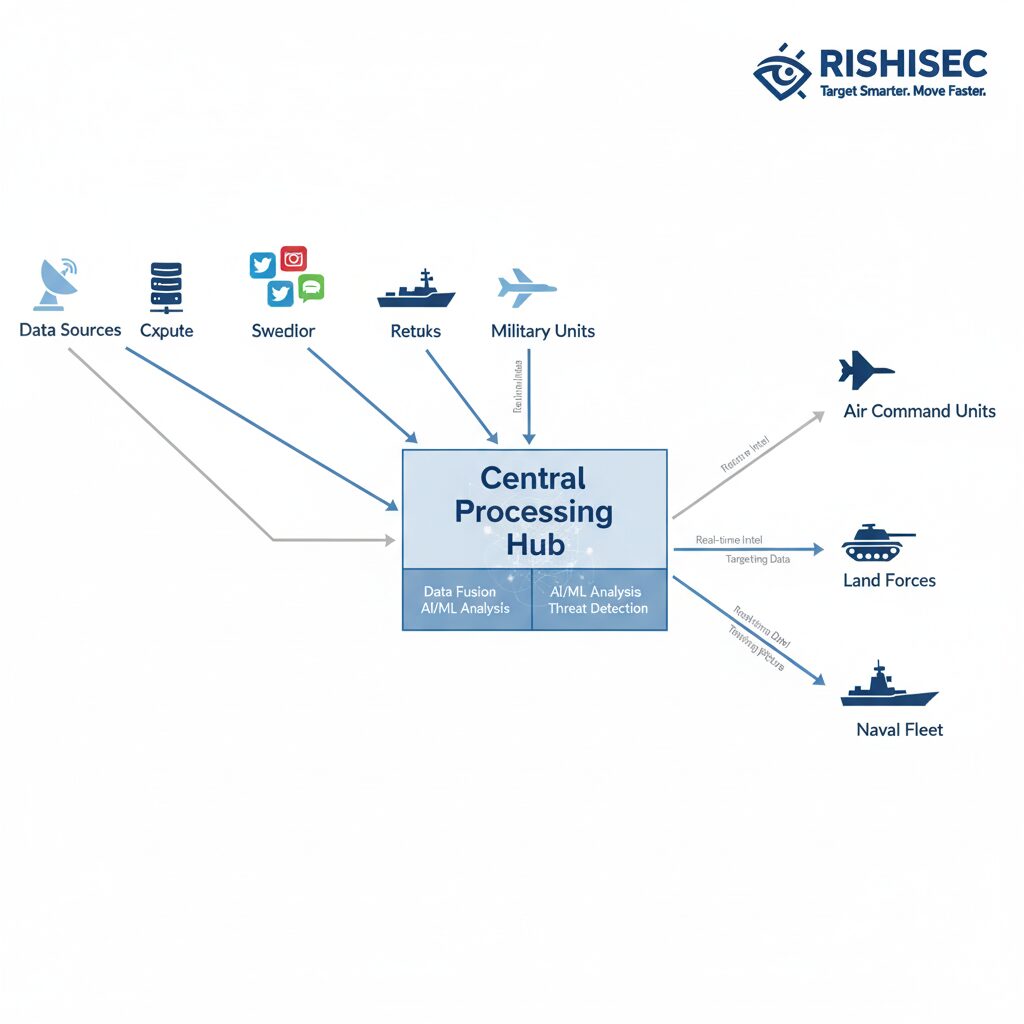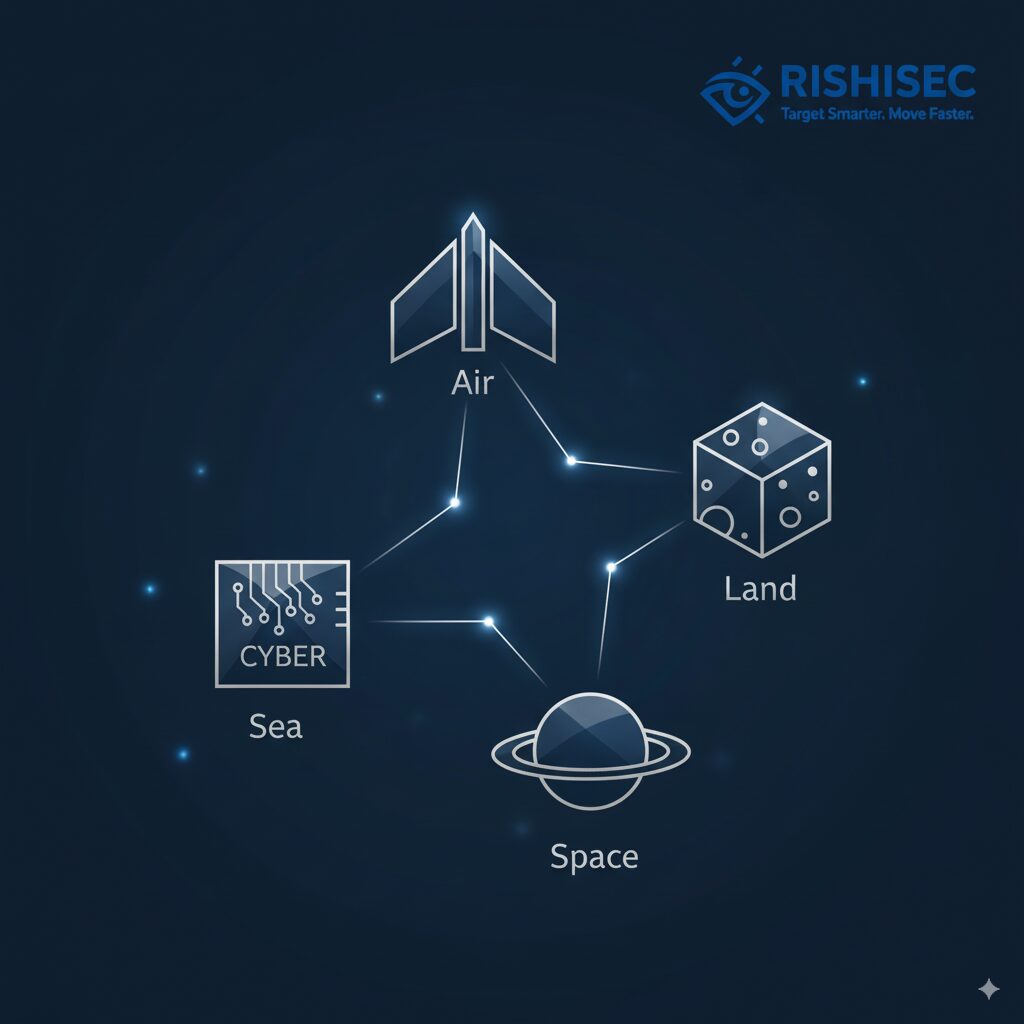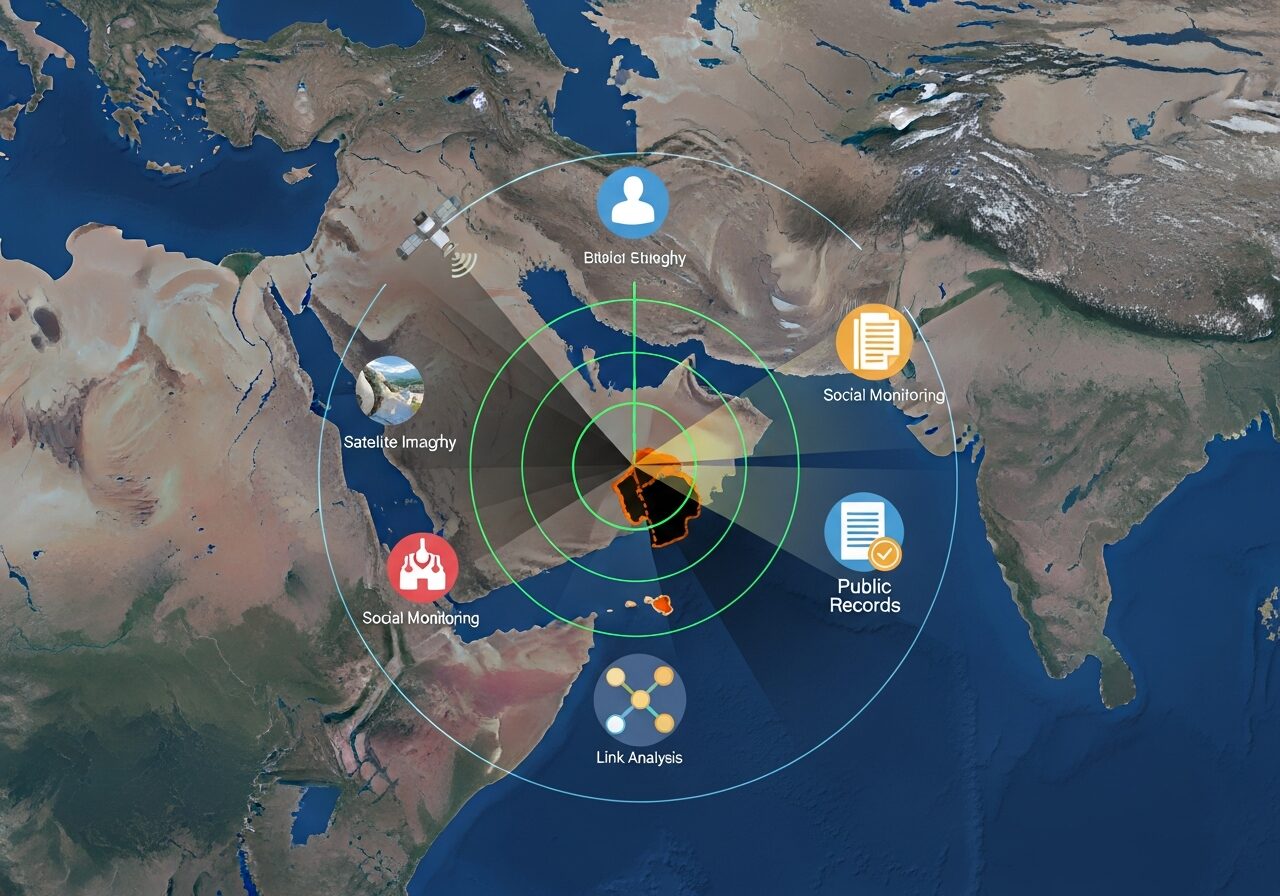Multi-domain operations intelligence represents a fundamental shift in how military organizations collect, analyze, and act on information. Unlike legacy approaches that treated air, land, sea, cyber, and space as separate intelligence silos, today’s operational environment demands integrated visibility across all domains simultaneously. This integration challenge has made open source intelligence more critical than ever before.
The Defense Intelligence Agency’s 2024 OSINT Strategy explicitly recognizes this reality, emphasizing that publicly available information now provides crucial context for understanding cross-domain threats. However, most military intelligence teams still struggle with the practical implementation of true multi-domain OSINT operations.
Why Traditional Intelligence Collection Fails in Multi-Domain Environments
Legacy military intelligence structures were designed for a different era. Air intelligence units focused on aerial threats, naval intelligence tracked maritime activities, and cyber teams monitored digital networks. Each domain operated with its own collection priorities, analytical frameworks, and reporting chains.
This compartmentalized approach creates dangerous blind spots. Consider a scenario where hostile forces use commercial satellites to coordinate naval movements, employ social media for tactical deception, and leverage civilian maritime traffic for reconnaissance. Traditional intelligence structures would process these activities separately, missing the integrated operational picture that reveals the true threat.
The volume and velocity of open source data compound this challenge. Manual OSINT collection methods cannot keep pace with the information flowing across multiple domains. An analyst monitoring satellite imagery, social media, maritime tracking systems, and aviation databases simultaneously would drown in data without automated correlation capabilities.

Time synchronization across domains adds further complexity. A cyber reconnaissance operation might precede a physical maritime movement by hours or days. Intelligence systems must correlate activities across different temporal scales, recognizing patterns that span domains and timeframes.
Open Source Intelligence as the Multi-Domain Integration Layer
OSINT provides the connective tissue that enables true multi-domain intelligence operations. Unlike classified collection systems that often operate in domain-specific channels, open source information flows across all domains naturally. Commercial satellite imagery, social media posts, flight tracking data, maritime vessel movements, and cybersecurity reporting all exist in the same information ecosystem.
This characteristic makes OSINT uniquely suited for detecting cross-domain patterns. When an analyst can simultaneously query shipping manifests, satellite overflight schedules, social media activity, and domain registration records, connections that would remain invisible in stovepiped systems become apparent.
Modern platforms like Kindi enable this integration by automating data collection across multiple open sources while providing link analysis capabilities that reveal relationships between entities, events, and activities across domains. The platform’s AI-powered correlation helps intelligence teams identify multi-domain patterns without requiring manual cross-referencing of dozens of separate data sources.
Temporal correlation represents a particularly powerful application of integrated OSINT. By tracking how information flows across domains over time, analysts can identify preparation activities, operational patterns, and potential future actions. For example, increased social media activity in a specific region, combined with commercial satellite imagery showing equipment movements and flight tracking data indicating transport aircraft activity, might indicate preparations for a significant operation.

Building Effective Multi-Domain OSINT Capabilities
Successful multi-domain operations intelligence requires more than just technology. Organizations must restructure their analytical processes, training programs, and operational workflows to support integrated collection and analysis.
Cross-domain analytical teams represent the foundation of effective multi-domain OSINT. Rather than maintaining separate units for each domain, military intelligence teams should create integrated cells where analysts with different domain expertise collaborate on shared intelligence problems. A cyber analyst working alongside a maritime intelligence specialist and a geospatial analyst can identify connections that would remain hidden if each worked independently.
Training programs must evolve to support multi-domain thinking. Analysts need familiarity with collection methods, data sources, and analytical frameworks across all domains, even if they specialize in one area. Understanding how satellite reconnaissance complements social media analysis, or how cyber activities correlate with physical movements, enables more sophisticated intelligence production.
Key Components of Multi-Domain OSINT Infrastructure
- Automated data aggregation systems: Tools that collect information from diverse open sources across all domains without manual intervention. This includes commercial satellite imagery, flight tracking, maritime AIS data, social media, news reporting, and technical cybersecurity feeds.
- Cross-domain correlation engines: AI-powered analytical capabilities that identify relationships between entities and activities across different domains. These systems must handle temporal analysis, geospatial correlation, and entity resolution across diverse data types.
- Collaborative analysis platforms: Systems that enable multiple analysts to work simultaneously on the same intelligence problem, sharing insights and building collective understanding of complex multi-domain situations.
- Visualization tools: Capabilities for representing multi-domain information in ways that reveal patterns and relationships. This includes network diagrams, temporal timelines, geospatial mapping, and link analysis visualizations.
- Integration with classified systems: While maintaining appropriate security boundaries, multi-domain OSINT platforms should feed insights into classified intelligence systems and receive taskings from operational commanders.
Data quality and verification processes become even more critical in multi-domain environments. With information flowing from numerous sources, intelligence teams must implement rigorous validation procedures to ensure analytical conclusions rest on reliable foundations. This includes cross-referencing open source information against multiple independent sources and understanding the provenance of each data element.
Operational Applications of Multi-Domain OSINT
The practical value of multi-domain operations intelligence becomes clear when examining real-world applications. Force protection represents one immediate use case. By monitoring social media for threat indicators, tracking suspicious vessel movements near naval facilities, correlating cyber reconnaissance activities against military networks, and analyzing satellite imagery of potential launch sites, intelligence teams build comprehensive threat pictures that inform security decisions.

Indications and warning systems represent another critical application. Multi-domain OSINT enables intelligence teams to detect preparation activities that precede hostile actions. Changes in satellite positioning, increased cyber reconnaissance, unusual maritime traffic patterns, and social media activity all contribute to warning indicators. When analyzed in isolation, these signals might appear benign, but multi-domain correlation reveals concerning patterns.
Strategic intelligence production gains depth from multi-domain analysis. Understanding adversary capabilities requires examining not just their physical military assets but also their space-based intelligence systems, cyber warfare capabilities, information operations infrastructure, and command and control networks. Open source intelligence provides visibility into many of these capabilities through commercial imagery, technical reporting, and analysis of publicly observable activities.
Overcoming Implementation Challenges
Despite clear benefits, military organizations face significant obstacles when implementing multi-domain OSINT capabilities. Organizational resistance represents perhaps the greatest challenge. Traditional intelligence structures have existed for decades, and personnel may resist changes that disrupt established workflows and reporting relationships.
Leadership commitment is essential for overcoming this resistance. Senior intelligence officers must champion multi-domain approaches, allocate resources for necessary technology investments, and reform personnel policies to reward cross-domain expertise. This includes revising training curricula, modifying performance evaluation criteria, and creating career paths for multi-domain intelligence specialists.
Technical integration challenges require careful planning. Legacy intelligence systems often lack APIs or data export capabilities, making it difficult to integrate their outputs with modern OSINT platforms. Organizations must develop data pipelines, standardize formats, and implement security controls that enable information sharing while protecting classified data.
Resource constraints affect many military intelligence organizations. Building multi-domain OSINT capabilities requires investments in technology, training, and personnel. However, these investments generate significant returns by improving intelligence quality, reducing analytical timelines, and enabling more effective operational support. Platforms like Kindi provide cost-effective solutions by automating labor-intensive collection and analysis tasks that would otherwise require substantial personnel resources.
Policy and legal considerations add another layer of complexity. Intelligence collection activities, even using open sources, must comply with applicable laws and regulations. Multi-domain OSINT operations that span international boundaries require careful attention to jurisdiction, privacy protections, and collection authorities. Organizations should establish clear policies governing collection activities and provide regular training on legal and ethical considerations.
The Future of Multi-Domain Operations Intelligence
As military operations become increasingly complex, multi-domain intelligence capabilities will become even more critical. Several emerging trends will shape this evolution over the coming years.
Artificial intelligence and machine learning will play expanding roles in multi-domain OSINT. Current AI capabilities enable automated data collection, entity resolution, and basic pattern recognition. Future systems will provide more sophisticated analytical support, identifying subtle correlations across domains, predicting adversary actions, and generating actionable intelligence with minimal human intervention.
The proliferation of sensors across all domains will increase both the volume and variety of open source information available for intelligence purposes. Commercial satellite constellations, Internet of Things devices, social media platforms, and cybersecurity monitoring systems all generate data that can support multi-domain analysis. Intelligence organizations must develop capabilities to ingest, process, and analyze these diverse data streams.
Integration with autonomous systems represents another frontier. As militaries deploy more unmanned vehicles, from aerial drones to undersea autonomous vehicles, intelligence systems must provide real-time multi-domain situational awareness to support their operations. This requires near-instantaneous data processing and analytical capabilities that current systems cannot provide.
Collaboration capabilities will become increasingly important as multi-domain operations require coordination across different military services, allied nations, and civilian agencies. OSINT platforms must support secure information sharing while maintaining appropriate access controls. The ability for intelligence teams from different organizations to collaborate on shared analytical problems will determine operational effectiveness in coalition operations.
Conclusion
Multi-domain operations intelligence represents the future of military intelligence. As adversaries exploit connections between air, land, sea, cyber, and space domains, intelligence teams must develop capabilities to understand and counter these integrated threats. Open source intelligence provides the foundation for this integration, offering visibility across all domains through publicly available information.
Success requires more than just technology adoption. Military intelligence organizations must transform their structures, processes, and cultures to support true multi-domain thinking. This means breaking down traditional stovepipes, training analysts to think across domains, and investing in platforms that enable automated data collection and correlation.
The intelligence organizations that master multi-domain OSINT will gain decisive advantages in future conflicts. They will detect threats earlier, understand adversary intentions more clearly, and provide commanders with the insights needed for effective decision-making across all domains of warfare.
Want to transform your military intelligence operations with multi-domain OSINT capabilities? Explore Kindi to see how AI-powered automation and link analysis can integrate your intelligence collection across all domains. Ready to build your team’s expertise? Check out our OSINT courses for practical, hands-on training in multi-domain intelligence operations.
FAQ
What are the five domains in multi-domain operations?
The five domains in multi-domain operations are air, land, sea, cyber, and space. Modern military operations recognize that adversaries conduct activities across all these domains simultaneously, requiring integrated intelligence capabilities that can track and analyze threats regardless of which domain they operate in. OSINT provides visibility across all domains through publicly available information sources.
How does OSINT support multi-domain operations differently than classified intelligence?
OSINT offers unique advantages for multi-domain operations because open source information naturally crosses domain boundaries. While classified collection systems often operate within specific domains or channels, commercial satellite imagery, social media, flight tracking, maritime data, and cybersecurity reporting exist in the same information ecosystem. This makes OSINT particularly effective for identifying cross-domain patterns and relationships that might remain invisible in compartmentalized classified systems.
What technology infrastructure is required for multi-domain OSINT operations?
Effective multi-domain OSINT requires automated data aggregation systems that collect information from diverse sources, AI-powered correlation engines that identify relationships across domains, collaborative analysis platforms for team-based intelligence production, visualization tools that represent complex multi-domain information clearly, and integration capabilities that connect OSINT insights with classified intelligence systems. Modern platforms like Kindi provide these capabilities in unified solutions designed specifically for intelligence operations.
How long does it take to implement multi-domain OSINT capabilities?
Implementation timelines vary based on organizational size, existing technology infrastructure, and resource availability. Basic multi-domain OSINT capabilities can be established within a few months using modern platforms, but developing mature capabilities with trained personnel, refined processes, and full integration typically requires 12 to 18 months. Organizations should plan for phased implementation, starting with pilot programs that demonstrate value before full-scale deployment.
What skills do analysts need for multi-domain OSINT operations?
Multi-domain OSINT analysts need broad knowledge across all five domains, understanding how activities in one domain affect others. This includes familiarity with commercial satellite imagery, social media intelligence, maritime and aviation tracking, cyber threat intelligence, and geospatial analysis. Analysts should also develop skills in link analysis, temporal correlation, and automated tool usage. Most importantly, they need the ability to think across traditional domain boundaries and identify patterns that connect diverse activities.



